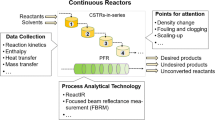Abstract
To increase the yield of monoclonal antibody in a hybridoma culture, it is important to optimize the combination of several factors including cell density, antibody productivity per cell, and the duration of the culture. Potassium acetate enhances the production of antibodies by cells but sometimes depresses cell density. The production of anti-(human B-type red blood cell surface antigen) antibody by Cp9B hybridoma was studied. In batch cultures, potassium acetate inhibited Cp9B cells growth and decreased the maximal cell density but the productivity of antibody per cell was increased. The balance of the two effects resulted in a slight decline of antibody production. In a stirred tank bioreactor, the inhibitory effect of potassium acetate on cell density was overcome by applying the perfusion technique with the attachment of a cell-recycling apparatus to the bioreactor. In such a reactor, potassium acetate at 1 g l-1 did not cause a decrease in the cell density, and the antibody concentration in the culture supernatant was increased from 28 μg ml-1 to 38 μg ml-1. Potassium acetate also suppressed the consumption of glucose and the accumulation of lactate in batch cultures, but the glucose and lactate levels were kept stable by applying the perfusion technique in the stirred tank bioreactor.
Similar content being viewed by others
References
Al-Rubeai M and Emery AW (1990) Mechanisms and kinetics of monoclonal antibody synthesis and secretion in synchronous and asynchronous hybridoma cell cultures. J, Biotechnol. 16: 67–86.
Al-Rubeai M, Emery AW, Chalder S and Han DC (1992) Specific monoclonal antibody productivity and the cell cycle comparisons of batch, continuous and perfusion cultures. Cytotechnology 9: 85–97.
Fawcett J and Scott J (1960) A rapid and precise method for the determination of urea. J. Clin. Path. 13: 126159.
Gaertner HG and Dhurjati P (1993) Fractional factorial study of hybridomas behavior. 1. Kinetics of growth and antibody production. Biotechnol. Prog. 9: 298–308.
Gentry A, Morse PA and Potter VR (1965) Pyrimidine metabolism in tissue culture cells derived from rat hepatomas. III. Relationship of thymidine to the metabolism of other pyrimidine nucleosides in suspension cultures derived from the Novikoff hepatoma. Cancer Res. 25: 517–525.
Glacken MW, Adema E and Sinskey AJ (1988) Mathematical descriptions of hybridoma culture kinetics: 1. Initial metabolic rates. Biotechnol. Bioeng. 32: 491–506.
Martinelle K and Häggström L (1994) Detoxification of ammonium in bioreactor cultivations. In: Animal Cell Technology: Products of Today, Prospects for Tomorrow, Spier RE, Griffiths JB, Berthold W (eds.), pp. 158–160, Butterworth-Heinemann.
Merten OW (1988) Batch production and growth kinetics of hybridomas. Cytotechnology 1: 113–122.
Miller WM, Blach HW and Wilke CR (1988) A kinetic analysis of hybridoma growth and metabolism in batch and continuous suspension culture: Effect of nutrient concentration, dilution rate, and pH. Biotechnol. Bioeng. 32: 947–965.
Oh SKW, Vig P, Chua F, Teo WK and Yap MGS (1993) Substantial overproduction of antibodies by applying osmotic pressure and sodium butyrate. Biotechnol. Bioeng. 42: 601–620.
Oyaas K, Berg TM, Bakke O and Levine DW (1989) Hybridoma growth and antibody production under conditions of hyperosmotic stress. In: Spier RE, Griffiths IB and Crooy PJ (eds.) Advances in animal cell biology and technology for bioprocesses (pp. 212–220). Butterworth. Essex.
Oztark SS and Palsson BO (1991) Effect of medium osmolarity on hybridoma growth, metabolism, and antibody production. Biotechnol. Bioeng 37: 989–993.
Somenshein GE and Brawerman G (1976) Differential translation of mouse myeloma messenger RNAs in a wheat germ cell-free system. Biochemistry 15: 5501–5506.
Suzuki E and Ollis DF (1990) Enhanced antibody production at slowed growth rates: Experimental demonstration and a structured model. Biotechnol. Prog. 6: 231–236.
Vits H and Hu W-S (1992) Fluctuations in continuous mammalian cell bioreactors with retention. Biotechnol. Prog. 8: 397–403.
Xu D, Zhou Y and Zhang Y (1994) Effects of potassium acetate on WuT3 cell growth and monoclonal antibody production. In: Two WK, Yap MGS and SKW (eds.) Better living through innovative biochemical engineering (pp. 226–228) Continental Press, Singapore.
Author information
Authors and Affiliations
Rights and permissions
About this article
Cite this article
Fong, W., Zhang, Y. & Yung, P. Optimization of monoclonal antibody production: combined effects of potassium acetate and perfusion in a stirred tank bioreactor. Cytotechnology 24, 47–54 (1997). https://doi.org/10.1023/A:1007914004727
Issue Date:
DOI: https://doi.org/10.1023/A:1007914004727




